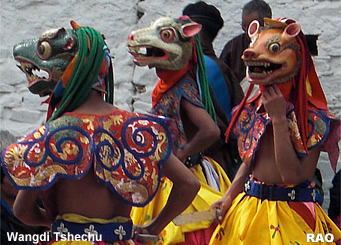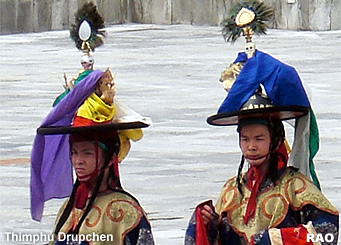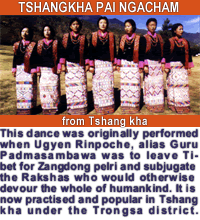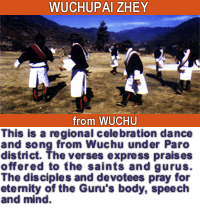|
Bhutanese
Folk , Drum and Mask Dance
|
|
Bhutanese
Folk and Mask Dance |
|
|
Nestled
in the southern foothills of the eastern Himalayas, Bhutan is the last
Mahayana Buddhist kingdom. Buddhism has had a tremendous impact on the
rich culture and traditions, and way of life of the Bhutanese people. Among
the most vivid manifestations of Bhutan's unique culture are the Chham
(sacred mask dance) performed at local temples and monasteries during Tsechu
(annual festival), and Zhabdro (folk song and dance),
which are popular throughout the country. While both monks and laypersons
perform mask dances, monks participate only during religious festivities.
Traditional dance forms play an important role in the religious and social
life of the people and reflect the deep devotion, compassion, tolerance,
and harmonious living.
The
origin of sacred mask dances lie in Buddhist traditions that date back
to the 8th century. |
|
By the middle of the 15th century, Bhutan
had developed its own sacred dance traditions associated with the Great
Terton (Treasurer Discoverer) Pema Lingpa (1450-1521).
Performed
before the celestial palace of Guru Padmasambhava, who introduced
Buddhism to Bhutan in the 8th century. Pema Lingpa's compositions
provide - interludes before and after the ritual climax of the festival,
besides forming the great part of the repertoire. Many of these dances
portray different sets of divine attendants and celestial beings preparing
a path to heaven.
The
Bhutanese consider the very act of watching sacred mask dances a spiritual
experience that can help one acquire merit and liberation from worldly
attachments. It also enables spectators with an opportunity to reaffirm
their devotion and commitment to lead virtuous lives. Adorned in
rich robes of silk and brocade, performers wear masks representing saints
and sages, protective deities, legendary personages, and animal forms.
The dances are accompanied by the music of cymbals, drums, large and
small horns, conches, and bells.
Bhutanese
folk song and dance, which pre-dates the 2 mask dances, can be classified
into two categories:
Zhungdra
(classical form) and
Boedra (court form)
Most
of the popular folk songs and dances can beattributed to the period of
renaissance in the arts that occurred during the reign of Zhabdrung
Ngawang' Namgyal (1594-1652), who unified Bhutan into a a single political
entity in the 17th century.
The folk
songs are natural and intuitive expressions of social mores and beliefs.
In addition to the universall themes of love, joy and sorrow, folk songs
reflect the interdependence and harmonious coexistence of man, all sentient
beings and nature, values that are deeply ingrained in the Bhutanese psyche.
Musical instruments like the dranyen (lute), pi-wang (fiddle), lim (flute)
and yangchin (dulcimer) accompany the songs and dances during formal
occasions and gatherings.
 |
Courtesy
RAPA |
top
| Information on Bhutan |
 |
|








